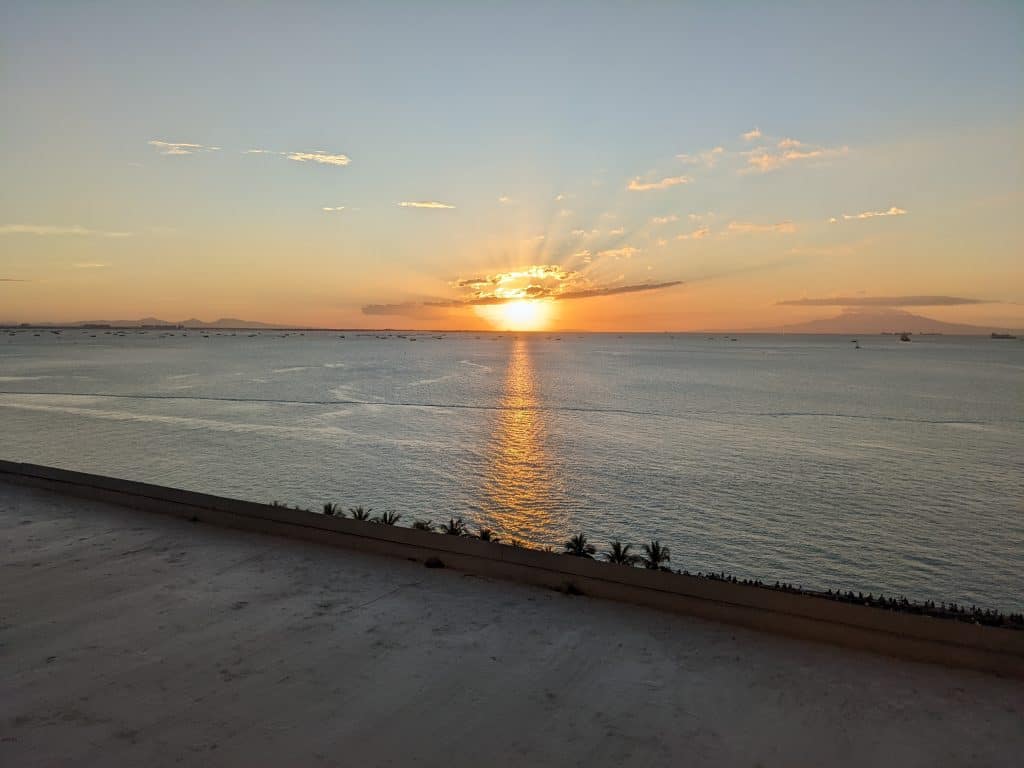What Is Manila Known For?
Manila is a destination for some, a jumping-off point for others, and of course home to many millions.
You’ll get as many takes as there are people. But, by and large, most will agree on a few particular things.
Domestically, Manila is known as the political, financial, and commercial capital of the Philippines. To travelers, Manila is rightly known as a chaotic city that’s the gateway to exotic destinations. For some visitors, that means stress and hassles; for others that means excitement and pleasant surprises galore.
Clearly, Manila is more than an affordable destination with convenient flights. Those things are true, but there’s a lot more to understand.
How I’d describe Manila (after traveling and living there)
Every single Western visitor to the cities of Metro Manila probably notices the chaos first and foremost.
It’s a special sort of chaos: not just hectic markets and bad traffic, but a dense yet sprawling free-for-all that coalesces into a functioning capital and metropolis in spite of itself.

No Western city is similar enough to draw an analogy. Other Southeast Asian capitals get close, but even oft-visited ones like Bangkok have striking differences.
However, for all its exotic feel and fundamentally different ways of life, the prevalence of English makes Manila uniquely accessible to foreigners. English is spoken in virtually every big city, but rarely does it play such a central role in daily life.
And that’s a great thing, because you’ll rarely find people warmer toward visitors.
All in all, Manila has a very different appeal from, say, a stroll along the Champs-Élysées.
What exactly is Manila famous for?
Manila has been a major Asian trading hub since the Spanish arrived centuries ago. It has remained the political center of the Philippines through Spanish, American, and finally domestic rule. Its historic district, Intramuros, goes back to 1571, although Tagalog people lived in the area for centuries prior.
Manila was pivotal in World War II, with events like the Battle of Corregidor and the particularly devastating Battle of Manila in headlines worldwide.
Today, Manila is most famous for the colonial architecture of Intramuros…

Striking sunsets over Manila Bay…

Extremely nice yet affordable central business districts…

and a plethora of shopping malls like the sprawling Mall of Asia.
Unfortunately, Manila is equally known for the darker sides to all the above.
Avoiding danger takes some precaution, the gorgeous bay stinks of pollutants and refuse, and the glitz is always within blocks of abject poverty.
Every city on Earth has variations of these, but their severity and contrast make a singular impression on foreigners in Manila.
Just how overpopulated is Manila?
Astounding population density is the first things most foreigners notice. Even from a descending plane, you can’t miss the mass of dwellings that cover every inch of habitable land.
By most standards, Metro Manila is severely overpopulated, meaning it lacks the infrastructure, environmental, and economic resources to support all of its inhabitants.
Crowdedness obviously diminishes toward the outskirts of the metro area, but the City of Manila and its adjacent municipalities are jam-packed with high-rises and slum dwellings alike.
In each of the last several years, metro population has grown by nearly a quarter-million people, or well over 1%. Immigration from the countryside is a major factor, although post-pandemic economic struggles may stem the inflows and (temporarily) compel workers to return to their home provinces.
There are obvious financial problems when population grows more quickly than decent employment. It also contributes to serious environmental issues, like the city’s ongoing sinking.
Places around Manila that are actually worth seeing
The City of Manila is surprisingly small, but Metro Manila is a large area that contains many popular spots. Most people use “Manila” to mean the whole region, and I’ll do the same.
It’s no accident that the old walled city of Intramuros is on the top of every itinerary. It’s a must-see if you’re at all interested in history or architecture. It’s also the only older district that’s easy and comfortable to navigate on foot in its entirety.
Bear in mind that there are several interesting spots inside Intramuros, so plan on at least half a day, or perhaps a full one if you like to linger in churches and museums. Some places—like Fort Santiago—charge nominal admission fees, and I’d say they’re well worth it.
Neighboring Rizal park is Manila’s prettiest and most famous. Just a couple hundred south of Intramuros, it’s a natural stop and a nice respite from crowds and concrete.
The legendary Manila Bay sunset is visible from many rooftop venues, but the free alternative (if a bit smelly in some weather) is a waterfront promenade called the Baywalk.
Binondo, home to Manila’s Chinatown, is another popular stop just north across the Pasig River. Frankly, I don’t particularly enjoy it, but big fans of street food in particular (and Chinese food in general) will absolutely want to visit—ideally as part of a guided tour.
Instead, I would get a ride a few miles southeast to Makati. This is the financial center of the entire Philippines, and its wealth is manifest in gorgeous mall-condo complexes (especially Greenbelt and Glorietta), trendy clubs, fantastic restaurants, and a whole lot of white-collar expats. One or two miles farther east, Bonifacio Global City (BGC) in the city of Taguig is a similar but newer area—and arguably even nicer.
Makati and BGC are terrific areas to stay, especially if you’re in town for more than a couple of days. There are enough museums, malls, restaurants, and other attractions to fill multiple articles.
One slightly unorthodox suggestion, if you want an interesting but accessible slice of daily life, is to shop at Greenhills about five miles north. It’s definitely a bargain-hunter’s paradise, full of cheap Chinese goods and countless knock-offs, but can be quite fun to poke around. (Incidentally, it’s also home to Carousel Creamery, the best ice cream shop on the planet.) Of course Divisoria is the most famous “authentic” market in town, but Greenhills is indoors and less overwhelming.
Just two warnings: it’s a hotspot for pickpockets and bag-snatchers (although we’ve never had a problem), and the traffic along EDSA from Makati or BGC is very bad even by Manila standards.
Finally, the Tomas Morato district of Quezon City is a good and essentially zero-tourist area for food and drinks, as well as some worthwhile art galleries. I enjoy the area and its slightly under-the-radar finds, but travel time from Manila proper, Makati, or BGC makes it inconvenient on short trips.
If you have an extra two days and a night, I’d highly recommended getting a breath of fresh air in Tagaytay. It’s rather far, so expect $15-$20 for a Grab ride and a whole lot of traffic, but the scenery is spectacular.
Or, for a couple nights and a half-day’s drive, Baguio is a popular destination to the north. The city itself is over-developed and hardly relaxing, but the pine-covered mountains and remarkably cool air make it worth springing for a more resort-style hotel.
To see all the above, stay at least a few days
If you want to see the essential sights and then move on, two full days in Manila will suffice. That might amount to three nights, depending on your flight times. You may prefer to stay in the City of Manila or near the Mall of Asia for convenience.
If you’d rather keep a leisurely pace, and take time to explore more freely, then around five full days will be comfortable. In that case, I’d strongly recommend staying in Makati. It’s a high-end area, but not necessarily expensive by Western standards.
Obviously, your costs will depend on how much comfort and convenience you want, but costs are quite modest on the whole. This article about budgeting for Manila travel may help.
All in all, you’ll enjoy Manila most if you avoid the temptation to cram your itinerary to the brim. The traffic is a given, so you’ll be glad if you leave time to stop and smell the roses. Or the diesel.
As a tourist, danger is exaggerated
I’ve done all the above, and far more, without a single safety problem.
Others haven’t been as lucky, but they do seem to be a small minority.
Either way, Manila’s chaos and poverty do show up in theft, scams, and occasionally some grave crimes. Again, these are not the norm, but I’d be remiss not to mention them.
The topic of travel safety in Manila is a slightly complicated one that I’ve addressed elsewhere. I recommend reading that article and doing your own research, but the upshot is simple: be aware, be inconspicuous, and take particular care to avoid taxis and questionable nightlife.
If you do, then while Manila is inherently more dangerous than, say Vienna, it’s overwhelmingly likely that you’ll be just fine.
Not everyone should stay in Manila
There are several reasons why Manila is worth visiting, but it’s not to everyone’s taste.
If you’re looking for a kick-back-on-the-beach sort of trip, then skip the city and hop on the next flight to Boracay or Bohol!
On the other hand, if you want to experience a very different type of city and can deal with the hecticness, then Manila will be nothing if not interesting.
Either way, I hesitate to recommend it as the sole destination for your trip unless you’re also visiting friends or family. Cities like Bangkok offer some similar charms with fewer of the worst headaches.








